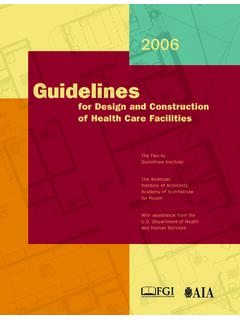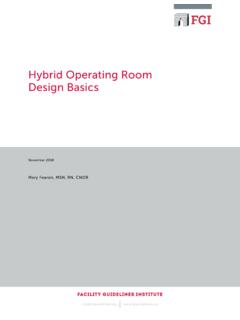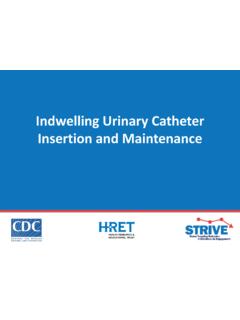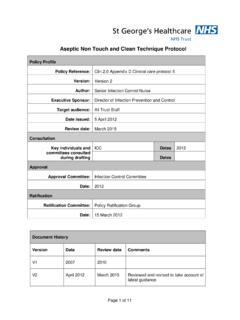Transcription of 2014 FGI Guidelines Update Series
1 2014 FGI Guidelines Update Series FGI Guidelines Update #3 September 15, 2014. Operating Room Requirements for 2014 and Beyond Byron Burlingame, MS, RN, CNOR. A comparison of the inpatient surgery section ( ) and the ambulatory surgery center chapter ( ) in the 2014 edition of the FGI Guidelines for Design and Construction of Hospitals and Outpatient Facilities to the same sections in the 2010 edition of the FGI Guidelines for Design and Construction of Health Care Facilities reveals a number of changes. Most of these modifications were made to bring the requirements for inpatient and outpatient surgery facilities into closer alignment, which means the language will largely be familiar. However, some intentional differences remain, the primary one being the size of operating rooms.
2 As surgical procedures previously performed primarily in an inpatient setting are increasingly taking place in outpatient facilities, the Health Guidelines Revision Committee (HGRC). members believe the physical environment for surgery should meet the same standards no matter where that surgery takes place. At the same time, they wanted to leave enough flexibility in the outpatient requirements to accommodate the space requirements of outpatient procedures that do not require a lot of equipment or staff but do require an aseptic field . Guidelines requirements are In a review of the 2010 requirements, the HGRC intended to be minimum Specialty Subgroup on Operating Rooms standards, but these minimums identified several important components of the ambulatory surgery text that needed must result in environments that improvement.
3 To address this, the group started support the safety of both with a thorough comparison of inpatient and patients and staff in all locations ambulatory surgery text in the 2010 edition. This effort revealed that some requirements in the where surgery takes place. ambulatory surgery chapter did not exist in the inpatient surgery section and vice versa. This article will highlight the key changes in the surgery sections that resulted from the group's work and the public review of their proposed changes. New Definitions In the glossary of the 2014 Guidelines for Design and Construction of Hospitals and Outpatient Facilities, new definitions have been provided for procedure room, invasive procedure, and the two areas that make up the surgical suite semi-restricted and restricted.
4 These definitions are the foundation for the changes made in the body of the document, especially the distinction between an operating room and a procedure room and the types of procedures performed in each. 2014 The Facility Guidelines Institute Invasive procedure is a broad term often used to describe procedures from a simple injection to a major surgical operation. For the purposes of the Guidelines , however, an invasive procedure is defined as a procedure that penetrates the protective surfaces of a patient's body ( , skin or mucous membranes), is performed in an aseptic surgical field , generally requires entry into a body cavity, and may involve insertion of an indwelling foreign body.
5 Such procedures must be performed in an operating room suitable to the technical requirements of the procedure with consideration of infection prevention and anesthetic risks and goals. The intent is to provide a safe environment for procedures that carry a high risk of infection, either by exposure of a usually sterile body cavity to the external environment or by implantation of a foreign object(s). into a normally sterile site. Procedures performed through orifices normally colonized with bacteria and percutaneous procedures that do not involve an incision deeper than skin are not included in this definition. A procedure room is defined as a room for the performance of procedures that do not require an aseptic field but may require use of sterile instruments or supplies.
6 Procedure rooms are considered unrestricted areas. Local anesthesia and minimal and moderate sedation may be administered in a procedure room, but anesthetic agents used in procedure rooms must not require special ventilation or scavenging equipment. An operating room (OR) is defined as a room in the surgical suite that meets the requirements of a restricted area and is designated and equipped for performing surgical operations or other invasive procedures that require an aseptic field . Any form of anesthesia may be administered in an OR as long as appropriate anesthesia gas administration devices and exhaust systems are provided. A hybrid operating room is an operating room that has permanently installed equipment to enable diagnostic imaging before, during, and after surgical procedures.
7 (Use of portable imaging technology does not make an OR a hybrid operating room.). A restricted area in a surgical suite is a designated space that can only be accessed through a semi-restricted area in order to achieve a high level of asepsis control. Traffic in the restricted area is limited to authorized personnel and patients, and personnel are required to wear surgical attire and cover head and facial hair. Masks are required where open sterile supplies or scrubbed persons may be located. A semi-restricted area comprises the peripheral support areas surrounding the restricted area of a surgical suite. These support areas include facilities such as storage areas for clean and sterile supplies, sterile processing rooms, work areas for storage and processing of instruments, scrub sink areas, corridors leading to the restricted area, and pump rooms.
8 Related definitions clarified in the 2014 glossary include those for spaces in pre- and postoperative patient care areas. A patient care station is a designated space where a specific patient care function takes place; the term does not imply any structural requirement. The structural requirements, instead, are included in the definitions of bays and cubicles, which are types of patient care stations: A bay has one hard wall at the headwall and three soft walls (cubicle curtains or portable privacy screens), and a cubicle has at least one opening and no door FGI Guidelines Update #3: Operating Room Requirements for 2014 and Beyond 2. and is enclosed on three sides with full- or partial-height partitions.
9 A patient care station can also be a room. Surgical Suite Outpatient Surgery Facilities In previous editions of the Guidelines , operating rooms in ambulatory surgery centers were classified according to the A C levels based on anesthesia use from an American College of Surgeons document on office-based surgery, which has not been published for more than 10. years. Determining requirements such as size and location of an operating room according to the type and level of anesthesia administered is no longer practical. The minimum space in today's operating rooms must be sufficient to accommodate all equipment and personnel needed in the OR, not just the equipment and personnel associated with administration of anesthesia.
10 For example, a hernia repair can be performed under local, regional, or general anesthesia and the size of the OR for the procedure should not be based on the type of anesthesia used but on the equipment and number of staff required. In Chapter (Outpatient Surgical Facilities) in the 2014 Guidelines , the decision to move away from levels of anesthesia as a determinant of room size resulted in a minimum size requirement for an outpatient operating room (formerly Class B and Class C) of 250 square feet. Recommendations for sizing ORs that may need to be larger are included in the appendix. The room previously known as a Class A operating room is now referred to as a procedure room and has a minimum clear floor area of 150 square feet.









